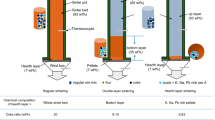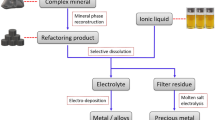Abstract
The possibility of selective solid-phase reduction of iron from oolitic ore has been experimentally confirmed. Solid phase reduction was carried out at temperatures of 850 and 1000°C in a CO atmosphere and in a mixture with solid carbon. Distribution of iron and phosphorus was investigated with a scanning electron microscope. It was found that at a temperature of 1000°C a minimum amount of phosphorus (up to 0.3%) is transformed into the metallic phase upon reduction with carbon monoxide. Upon reduction in a mixture of ore with carbon, the phosphorus content in the metal phase reaches 1.0–1.3% even at a temperature of 850°C. Thermodynamic modeling of the processes occurring during reductive roasting of oolitic ore was carried out depending on temperature (1000–1400 K) and amount of carbon in the system. It is shown that reduction temperature and degree of phosphorus reduction vary depending on the ratio of CO and CO2 in the gas phase. At temperatures below 892°C, phosphorus is not reduced, and all iron is in the metal phase. With an increase in the amount of carbon in the system, phosphorus appears in the metal phase. With an excess of carbon in the system, all phosphorus is in the metal phase at a temperature of 892°С. Thus, with a certain amount of carbon in the system and, correspondingly, with a certain ratio of CO and CO2 in the gas phase, selective reduction of iron is possible without phosphorus reduction even at a temperature of 1100°С. Comparison of experimental results with results of thermodynamic calculation confirms the possibility of selective reduction of iron without phosphorus reduction only by carbon monoxide.





Similar content being viewed by others
REFERENCES
Vegman, E.F., Zherebin, B.N., Pokhvisnev, A.N., Yusfin, Yu.S., Kurunov, I.F., Paren’kov, A.E., and Chernousov, P.I., Metallurgiya chuguna (Cast Iron Metallurgy), Yusfin, Yu.S., Ed., Moscow: Metallurgiya, 1978.
Mirko, V.A., Kabanov, Yu., and Naidenov, V., Current state of deposits of brown iron ore in Kazakhstan, Prom-st’ Kazakh., 2002, no. 1, pp. 79–82.
Smirnov, L.A. and Babenko, A.A., Introduction of Lisakovsky concentrate in production as one of the directions for expanding iron ore base of the Urals and Siberia, Materialy Mezhdunarodnogo kongressa “300 let Ural’skoi metallurgii” (Proc. Int. Congr. “300 Years of the Ural Metallurgy”), Yekaterinburg: Ural. Gos. Univ., 2001, pp. 48–49.
Cao, Y.Y., Zhang, Y.R., and Sun, T.C., Dephosphorization behavior of high-phosphorus oolitic hematite-solid waste containing carbon briquettes during the process of direct reduction-magnetic separation, Metals, 2018, vol. 11, no. 8, art. ID 897.
Tigunov, L.P., Anufrieva, S.I., Bronitskaya, E.S., Krivokoneva, G.K., Sokolova, V.N., Alikberov, V.M., Sladkova, G.A., Fainshtein, G.G., and Parovinchak, M.S., Modern technological solutions for processing of iron ores of the Bakcharskii deposit, Razved. Okhr. Nedr, 2010, no. 2, pp. 37–43.
Li, K., Ni, W., Zhu, M., Zheng, M., and Li, Y., Iron extraction from oolitic iron ore by a deep reduction process, J. Iron Steel Res. Int., 2011, vol. 18, no. 8, pp. 9–13.
Yu, Y.F. and Qi, C.Y., Magnetizing roasting mechanism and effective ore dressing process for oolitic hematite ore, J. Wuhan Univ. Technol.: Mater. Sci., 2011, vol. 26, no. 2, pp. 177–182.
Sun, Y.S., Han, Y.X., Gao, P., Wang, Z.H., and Ren, D.Z., Recovery of iron from high phosphorus oolitic iron ore using coal-based reduction followed by magnetic separation, Int. J. Miner., Metall., Mater., 2013, vol. 20, no. 5, pp. 411–419.
Xu, C.Y., Sun, T.C., Kou, J., Li, Y.L., Mo, X.L., and Tang, L.G., Mechanism of phosphorus removal in beneficiation of high phosphorous oolitic hematite by direct reduction roasting with dephosphorization agent, Trans. Nonferrous Met. Soc. China, 2012, vol. 22, no. 11, pp. 2806–2812.
Li, G.H., Zhang, S.H., Rao, M.J., Zhang, Y.B., and Jiang, T., Effects of sodium salts on reduction roasting and Fe–P separation of high-phosphorus oolitic hematite ore, Int. J. Miner. Process., 2013, vol. 124, pp. 26–34.
Karelin, V.G., Zainullin, L.A., Epishin, A.Yu., and Artov, D.A., Features of pyro-, hydrometallurgical technology of dephosphorization of brown iron ore of the Lisakovskoye deposit, Stal’, 2015, no. 3, pp. 8–11.
Wang, H.H., Li, G.Q., Zhao, D., Ma, J.H., and Yang, J., Dephosphorization of high phosphorus oolitic hematite by acid leaching and the leaching kinetics, Hydrometallurgy, 2017, vol. 171, pp. 61–68.
Jin, Y., Jiang, T., Yang, Y., Li, Q., Li, G., and Guo, Y., Removal of phosphorus from iron ores by chemical leaching, J. Central South Univ. Technol., 2006, vol. 13, no. 6, pp. 673–677.
Wang, J., Shen, S., Kang, J., Li, H., and Guo, Z., Effect of ore solid concentration on the bioleaching of phosphorus from high-phosphorus iron ores using indigenous sulfur-oxidizing bacteria from municipal wastewater, Process Biochem., 2010, vol. 45, no. 10, pp. 1624–1631.
Tang, H., Guo, Z., and Zhao, Z., Phosphorus removal of high phosphorus iron ore by gas-based reduction and melt separation, J. Iron Steel Res., Int., 2010, vol. 17, no. 9, pp. 1–6.
Yu, W., Tang, Q., Chen, J., and Sun, T., Thermodynamic analysis of the carbothermic reduction of a high-phosphorus oolitic iron ore by FactSage, Int. J. Miner., Metall., Mater., 2016, vol. 23, no. 10, pp. 1126–1132.
Vatolin, N.A., Moiseev, G.K., and Trusov, B.G., Termodinamicheskoe modelirovanie v vysokotemperaturnykh neorganicheskikh sistemakh (Thermodynamic Modeling in High-Temperature Inorganic Systems), Moscow: Metallurgiya, 1994.
Gamov, P.A., Mal’kov, N.V., and Roshchin, V.E., Thermodynamic modeling of metal reduction from titanium-magnetite concentrates of the Suroyamskoe field, Vestn. Yuzh.-Ural. Gos. Univ.,Ser.: Metall., 2018, vol. 18, no. 2, pp. 21–28.
Okamoto, H., The Fe–P (iron–phosphorus) system, Bull. Alloy Phase Diagrams, 1990, vol. 11, no. 4, pp. 404–412.
Kubaschewski, O. and Alcock, C.B., Metallurgical Thermochemistry, Oxford: Pergamon, 1967.
Author information
Authors and Affiliations
Corresponding authors
Additional information
Translated by A. Muravev
About this article
Cite this article
Salikhov, S.P., Suleimen, B. & Roshchin, V.E. Selective Reduction of Iron and Phosphorus from Oolitic Ore. Steel Transl. 50, 460–466 (2020). https://doi.org/10.3103/S0967091220070128
Received:
Revised:
Accepted:
Published:
Issue Date:
DOI: https://doi.org/10.3103/S0967091220070128




